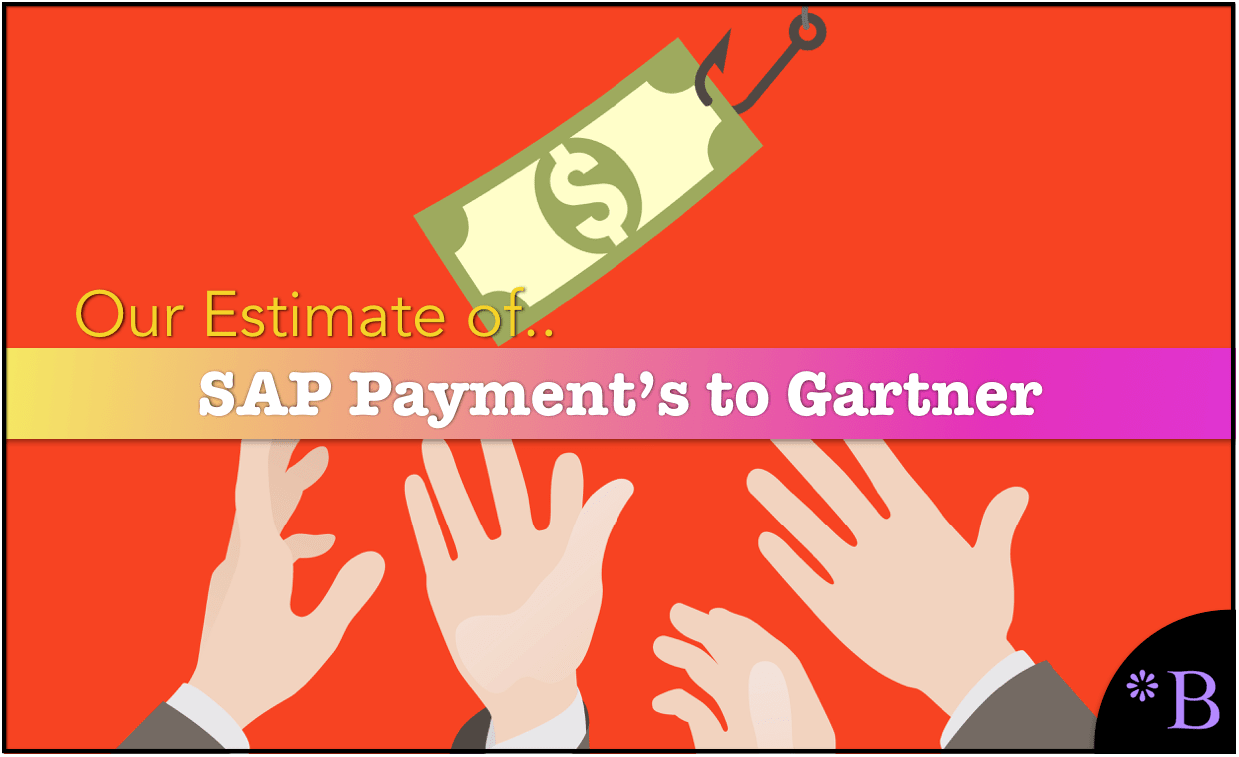Understanding The Brightwork Estimate of The Amount of Money Paid by SAP to Gartner Per Year
Executive Summary
- Brightwork Research & Analysis estimated the amount of money paid to Gartner every year.
- We cover how we arrived at our figure.

Video Introduction: Understanding The Brightwork Estimate of The Amount of Money Paid by SAP to Gartner Per Year
Text Introduction (Skip if You Watched the Video)
We sometimes are questioned how we came to our estimate that SAP pays roughly between $100 and $150 million to Gartner every year. We developed the estimate that we think SAP pays Gartner back when doing my research for Gartner and the Magic Quadrant. This seems shocking to many people. However, we wanted to explain how we came up with this estimate. What is curious is that it is most common to think that the amount of money paid to Gartner is low, even though Gartner charges very high prices to software vendors for things ranging from advisory to attending Gartner conferences.
Our References for This Article
If you want to see our references for this article and other related Brightwork articles, see this link.
Notice of Lack of Financial Bias: You are reading one of the only independent sources on Gartner. If you look at the information software vendors or consulting firms provide about Gartner, it is exclusively about using Gartner to help them sell software or consulting services. None of these sources care that Gartner is a faux research entity that makes up its findings and has massive financial conflicts. The IT industry is generally petrified of Gartner and only publishes complementary information about them. The article below is very different.
- First, it is published by a research entity, not an unreliable software vendor or consulting firm that has no idea what research is.
- Second, no one paid for this article to be written, and it is not pretending to inform you while being rigged to sell you software or consulting services as a vendor or consulting firm that shares their ranking in some Gartner report. Unlike nearly every other article you will find from Google on this topic, it has had no input from any company's marketing or sales department.
Issue #1: The Consensus Estimate
This came from discussing with several vendors about all the different ways that Gartner charges clients. Gartner salespeople are constantly shaking down vendors, and they also know the variety of ways that SAP makes money from vendors — ranging from advisement services to conference bookings, etc. Vendors were very free with this information because many of them want Gartner’s system exposed. Still, none of them can critique Gartner in public for fear of retaliation by Gartner. Gartner can reduce the vendor’s rating, giving Gartner enormous power to keep vendors silent. We covered this topic in the article How to Understand Gartner’s Control Over Vendors. One of the few vendors to call out Gartner is called ZL Technologies. ZL Technologies sued Gartner and asserted that Gartner was both financially biased, that Gartner discriminated against ZL Technologies in their MQ because ZL Technologies would not pay them, and that their ombudsman was a fake position designed to hide its financial bias. We cover this in the article How to Best Understand the Gartner Ombudsman.
Issue #2: The Total Income From Vendors
According to Gartner’s financial statements, the upward cap was “reality checked” against Gartner’s overall vendor revenue, which is somewhat less than 1/3 of all revenues. We cover this in the article. This means they receive (roughly) $1.5 B from vendors alone. The vendor market is highly Paretoed, meaning that the most significant vendors contribute disproportionately to Gartner. There are only a few “mega-vendors,” and they are monopolistic and have enormous financial resources. SAP is over $24 B in revenues. Oracle is $ 40 B. $150 million is easily affordable for them.
Issue #3: Why Vendors Pay Gartner
It has been stated repeatedly by many vendors that they ONLY pay Gartner because they know it’s how they can do well in the Magic Quadrants. Gartner has created a coercive business model where many vendors feel they are compelled to pay them.
Gartner’s cover story is that the payments from vendors are for their trenchant advice and has nothing to do with the positioning in Magic Quadrants. But that is not what vendors tell Brightwork, and that is not what Gartner salespeople tell vendors, where they explicitly tell vendors they need to pay more to compete with other vendors that are also paying.
How Gartner Helped Create SAP
Something often forgotten is that Gartner has been a significant driver for SAP’s growth. Gartner was a considerable proponent against custom development, as we cover in the article How to Understand Gartner and the Patent Software System, and in favor of packaged applications (as packaged application vendors could pay them and internal development departments could not) as well as supporting the superiority of ERP systems (without any evidence by the way). Gartner has been a constant cheerleader of SAP and other ERP vendors who have also paid Gartner to propose the necessity of ERP systems. Those large ERP vendors should be preferenced over best of breed vendors for non-ERP applications and versus custom development.
Conclusion
There is no way to guess precisely how much SAP spends on Gartner, which is why we developed a consensus forecast from people with decades of experience working with Gartner on the vendor side and understanding their revenue model very well. This is where the $150 million number came from. The number may be $100 million. But in either case, there is a very substantial amount of money flowing from SAP every year, and its effect is evident in how Gartner repeats SAP’s marketing and sales literature. For instance, how they were entirely inaccurate in their analysis around HANA, as we cover in the article How Gartner Distributes Press Releases On HANA. And their repeated inaccuracies (always positive, by the way) on virtually any SAP application or topic (see another example in the article How Gartner Got SAP Fiori So Wrong).
It is also worth considering that if any normal research context if a research entity refused to declare whether a company that it was researching and rating were paying it. Or how much it was paying, that research would have a challenging time being considered legitimate. In long term research into the IT research field, in every case that we have analyzed, whenever an entity sponsors a research study. This includes but not limited to IDC Takes Money to Publish SAP Provided Sample on S/4HANA, How Accurate Was The Forrester HANA TCO Study?)
That research turned out to be false but to be easily found to include massaging from the vendor and vendor marketing material. However, this issue of financial bias is nearly never mentioned by companies that have Gartner subscriptions.

The Problem: Thinking that Gartner is Focused on What is True
Gartner is hired by companies who fundamentally don’t understand how Gartner functions. Gartner has virtually no first-hand experience in the technologies they evaluate and get most of their information from executives at buyers or executives at vendors and consulting firms. Gartner is also not a research entity. They compare very poorly to real research entities once you dig into the details, as we did in the article How Gartner’s Research Compares to Real Research Entities. Gartner serves to direct IT spending to the most expensive solutions as these are the companies that can afford to pay Gartner the most money. Gartner has enormously aggressive internal sales goals that place accuracy far below revenue growth in importance.